BARS 101“Which bar should I buy?” Good question. With prices ranging from $50 to more than $900, you’ll want to choose the best bar for the money. Trouble is, there are dozens of choices and every manufacturePublished: Winter 2002 After 30 years in the business, we know what to look for. We’ll start by helping you identify your specific needs. Then we’ll show you how to decide on a bar that has the proper combination of price, strength and function. Sometimes, it’s just a matter of averaging the features out and choosing the bar with the highest score. Beware of False Advertising Tom Lincir, president of Ivanko Barbell Company, warns, “Some manufacturers throw around impressive-sounding measurements of a bar’s strength that are either irrelevant or misleading. Ratings like “1,000-pound test” or “2,000-pound test” may sound impressive because the numbers are big. However, there is no such thing as “1,000-pound test”-it is all a fantasy created in an attempt to satisfy buyers. “In reality, the measures that do count are tensile strength and yield strength. The tensile strength rating is the pounds per square inch (PSI) of force required to pull the bar apart and the yield strength is the amount of force it takes to bend the bar past the point where it will not return to its original position. Unfortunately, this is not something that can be seen so you have to rely on the integrity of the supplier.” Bar manufacturers come and go. It is a very difficult business to succeed in. You should try to stick with companies you trust when buying bars and not get sucked in by tricky phrases. Also, as you will see in the following breakdown of different bars, there are general price ranges that correspond to how strong a bar is. If you see a bar that costs only $80 and the manufacturer claims a 135,000 PSI yield strength, then it is probably safe to conclude that the strength of their bar is being exaggerated. Don’t get stuck with a sub-par bar from a company that will be nonexistent in a few years. Choosing a Squat Bar PSI: The main factor in choosing a good bar for squatting is tensile strength. For junior highs and beginning-to-mid-level lifters, you will be fine with general-purpose bars that have a yield strength of only 105,000 to 125,000 PSI. For your heavy lifters you should get bars with a PSI of at least 135,000. If you have a powerhouse athlete who is closing in on a 700-pound squat, you will want to consider a bar with 185,000 PSI or more. Special Features: A nice feature to have on your squat bars is center knurling. This will generally add about $20 to $30 to the cost of the bar. On the other hand, a feature that’s unnecessary on a squat bar is needle bearings. Needle bearings generally add $50 to $70 to the cost. Since you do not need an ultra-smooth spin on the sleeves when doing squats, you will save money by getting squat bars without this feature. Price: For beginning-to-mid-level lifters a good price range for a bar with a yield strength of 105,000 to 125,000 PSI is $90 to $120. If you find a bar for less than that, it usually means the bar has components that fall apart easily, such as shoulder bolts, or they have misrepresented its true PSI. I would avoid these bars. For your high school heavy lifters, a good range for a bar with a yield strength of 135,000 to165,000 PSI is $130 to $150. If you want center knurling, the price could go up to $170. For your super-heavy lifters, look at spending around $300-the price goes up substantially as the PSI gets higher. Choosing a Power Clean Bar PSI: For junior highs and beginning-to-mid-level lifters, you can get away with general-purpose bars with a yield strength of only 105,000 to 125,000 PSI. However, for your heavy lifters you should get bars with a PSI of at least 135,000. If you have athletes who are really into Olympic lifting and do overhead lifts, you should consider a bar with 185,000 PSI. Special Features: The more advanced a lifter gets with Olympic lifting, the more important good sleeve rotation becomes. Needle bearings generally add $50 to $70 to the cost of the bar and should be a main consideration for your heavy lifters. A feature you will want to avoid when choosing a power clean bar is center knurling-this could cause problems when lifting and racking the bar. The best bars for Olympic style lifts have a 28mm circumference and are made from flexible steel. For this type of lifting a bars ability to store and release energy is very important, especially when you start getting more weight on the bar. Price: For beginning-to-mid-level lifters a good price range for a bar with a yield strength of 105,000 to 125,000 PSI is $90 to $120 (without needle bearings or center knurling). If you find a bar for less than that, it usually means the bar has components that fall apart easily, such as shoulder bolts, or they have misrepresented its true PSI. Again, I would avoid such a bar. For your heavy lifters, a good range for a bar with a yield strength of 135,000 to 165,000 PSI is $130 to $150 (without needle bearings and center knurling). If you want needle bearings, add about $50 to the price. Choosing a Bench Press Bar When choosing a bar for your benches, it is good to know that the dynamic demands on your bar are not nearly as extreme as when doing squats or Olympic style lifts. Your bench bar, however, should be well constructed and have fairly deep knurling to assure a good grip. 30mm or even 32mm bars are fine when benching. PSI: For all athletes who lift under 400 pounds, general-purpose bars with a yield strength of only 105,000 to 125,000 PSI are fine. However, for those heavy lifters who bench over 400 pounds, you should get bars with a PSI of at least 135,000. Special Features: You do not need any special features for your bench bars. Price: Bars with a yield strength of 105,000 to 125,000 PSI are $90 to $120 (without needle bearings or center knurling). For your heavy lifters, a good range for bars with a yield strength of 135,000 to 165,000 PSI is $130 to $150 (without needle bearings and center knurling). Choosing a Deadlift Bar BFS recommends using hex bars for doing deadlifts. These special bars bring the weight into the center of the body, making it easier to stay in perfect position. You can get these bars with regular handles, or raised handles for your really tall athletes. Hex bars do not have rotating sleeves or moving parts so it is easy to compare bars from different companies. BFS does recommend that you stay away from the old-style trap-bar diamond design because they do not allow sufficient legroom when performing the lift. BFS has a 45-pound Hex Bar for $129; a 45-pound High-Hex Bar for $139; a 45-pound Combo Hex Bar (which includes a set of regular handles and a set of high handles) for $189; and for your powerhouses, a 75-pound Mega Hex Bar that holds nine 45-pound plates on each side for $249. For schools that like to have their advanced lifters do straight-bar deadlifts for special occasions or for those that simply do not have hex bars yet, refer to the following: PSI: The main factor in choosing a good bar for deadlifting is yield strength. BFS does not recommend deadlifting for junior high and beginning lifters, but for your mid-level lifters and heavy lifters you should get bars with a PSI of at least 135,000. For your extra-strong athletes who are closing in on a 700-pound squat, you will want to consider a bar with 185,000 PSI or more. Special Features: The only special feature for deadlift bars would be an aggressive knurling to enhance the athletes grip. Also, as with all bars, you will want to make sure you do not get bars with shoulder bolts. These bars are notorious for the bolt falling out and causing the sleeves to fall off. This can be very dangerous when doing any lift, but it is especially dangerous when doing heavy deadlifts and heavy squats. Price: Bars with a yield strength of 135,000 to 165,000 PSI are $130 to $150. For your super-heavy lifters, look at spending around $300-the price goes up substantially as |
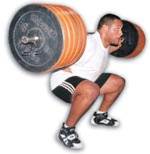 |
|
Squat |
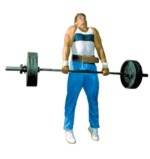 |
|
Clean |
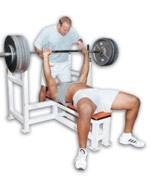 |
|
Bench |
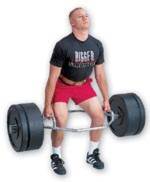 |
|
Dead Lift |
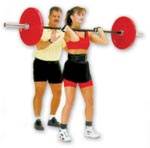 |
|
Teaching |